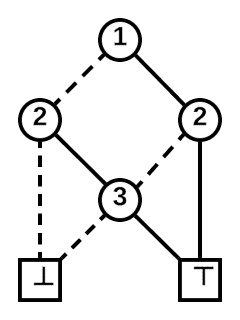Boolean Basics
January 29, 2019
Boolean Identities
This post is about a very basic topic in computer programming, which is boolean logic. The main goal here is to avoid formal notation, just write the Identities in an easy to read format.
(1)
($x || $y) && $z
($x && $z) || ($y && $z) (2)
($x && $y) || $z
($x || $z) && ($y || $z)(3)
$x === $y
!$x XOR $y
$x XOR !$y
true XOR $x XOR $y(4)
$x XOR $y
!$x === $y
$x === !$y
!($x === $y)(5)
$x XOR $y
($x + $y) % 2(6)
($x XOR $y) && $z
($x && $z) XOR ($y && $z)(7)
($x && $y) || $x
($x || $y) && $x
$x(8)
$x XOR $x
false(9)
($x XOR $y) XOR $x
$y
($x XOR $y) XOR $y
$x(10)
!$x
$x XOR true(11)
!($x && $y)
!$x || !$y(12)
!($x || $y)
!$x && !$y(13)
$x && $y
!(!$x || !$y)
$x XOR $y XOR ($x || $y)(14)
$x || $y
!(!$x && !$y)
$x XOR $y XOR ($x && $y)(15)
$x XOR $y
($x || $y) && !($x && $y)
($x && !$y) || (!$x && $y)(16)
$x && false
false
$x && true
$x XOR false
$xMedian operation
Takes three boolean arguments $x, $y and $z. Evaluates to false if most arguments are false, and true if most arguments are true.
($x && $y) || ($y && $z) || ($x && $z)
($x || $y) && ($y || $z) && ($x || $z)This is also:
- Monotone Boolean function: it can be expressed in terms of && and ||.
- Self-dual monotone formula: && and || can be interchanged.
For real numbers.
max(min($x, $y), min($y, $z), min($x, $z))
min(max($x, $y), max($y, $z), max($x, $z))Truth table
Truth table expresses binary function as a binary string. For example, the median operation is 00010111:
f(0,0,0) = 0
f(0,0,1) = 0
f(0,1,0) = 0
f(0,1,1) = 1
f(1,0,0) = 0
f(1,0,1) = 1
f(1,1,0) = 1
f(1,1,1) = 1Binary Decision Diagram (BDD)
Binary decision diagram expresses binary function as a diagram. For example, the median operation:
It has the following properties:
- It must be ordered.
- It must be reduced (not waste space).
References
http://www.cs.utsa.edu/~wagner/knuth/ Donald E. Knuth, The Art of Computer Programming Volume 4
